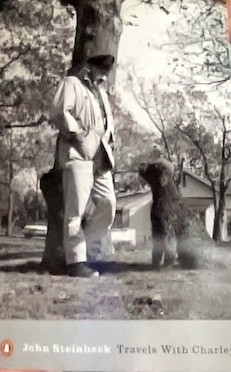Inspiring Older Readers
 posted on 15 Nov 2023
posted on 15 Nov 2023
Travels with Charley by John Steinbeck
In 1960, quite late in his life, John Steinbeck embarked on a road trip designed to help him rediscover America and Americans. For someone who had made a lifetime’s writing career based on observing the lives and struggles of Americans, Steinbeck felt he had allowed himself to neglect contemporary America. What he knew best from first-hand experience was over thirty years in the past. It was a situation he felt he had to put right — while he still had the physical and mental stamina to undertake such a trip.
And so, in 1960, in a specially-equipped pick-up truck with a camper cabin mounted on the flat-bed, and accompanied by his garrulous old French poodle, Charley, Steinbeck set out from his fishing cabin on Long Island to drive through Maine, New England and the Pacific Northwest, down through the Salinas Valley where he had grown up, to Texas and eventually back up to his family home in New York.
The camper van he christened Rocinante, after Don Quixote’s poor old spavined horse. One imagines that he saw himself as the gently melancholic and deluded knight-errant, Don Quixote, and Charley as the loyal squire, Sancho Panza. Certainly, just like Quixote in Cervante’s novel, he spends an inordinate amount of time addressing his companion in high-flown chivalric language.
I discovered this book by accident when I was about thirteen and to this day I have no idea where that drab, jacketless Readers’ Union hardback came from; perhaps a church hall jumble sale; perhaps a box of unwanted odds and ends from a neighbour. But whatever its source, it was love at first sight and each time I have read it since it has been with the kind of deepening pleasure that long familiarity and emotional attachment bring. In short, it is a book I love.
And I love it despite its faults — or perhaps I mean including its faults. For faults it does have. I think that like many of the greatest writers, Steinbeck became a little self-indulgent with age. He tended to a gruff kind of sentimentality, was partial to cracker-barrel philosophising and anthropomorphised animals (especially his own) almost without limit. But he never wrote less than well, his prose muscular and supple, but free of the virile, he-man excesses that increasingly marred Hemingway’s later work. Steinbeck’s is a voice of humane reason, fairness, justice and decency — and never pious or self-righteous.
Anyway, Travels with Charley, I now realise, is a marvellous but rare kind of travel book, because really it is primarily a thinking book, a book of reflection, a kind of taking stock, a reckoning. That this taking stock happens to be done on the move, with a dog for company and a pick-up truck for transport is almost incidental.
And unlike most travel books I can think of, it ends rather abruptly, with Steinbeck disillusioned and desperate for the journey to end. For in Texas, he realises that his trip cannot be considered complete if he fails to see at first hand the battle lines of the civil rights struggle in the south. And although a ‘weary nausea’ grips him at the very thought, he chooses to see the daily scrum of screaming and jostling mothers — he dubs them the ‘Cheerleaders’ — who are gathering daily in New Orleans to protest against the desegregation of schools. The women ‘perform’, screeching vile abuse at the parents and children being escorted under armed guard into the school — at the black children and their parents for seeking to enter the school, and at the white children and parents for not boycotting it.
Saddened and exhausted, Steinbeck can’t wait to get home and forces himself onwards to New York, racing the advancing winter. In a matter of pages he is back in the city that for years has been his home — but so sickened and disorientated that he has to ask a suspicious police officer to give him directions.
It is a dark and ambivalent ending, and indeed the book overall is darker than I remembered it, Steinbeck’s increasing preoccupation with environmental depredation — the greed and destruction of ‘development’, cherished landscapes from his youth sometimes scarcely recognisable, trash heaps and junked cars encircling every town he passes through — offering a prescient vision. But it is all done with such beautiful poise, control and balance that the beauty of the book isn’t overwhelmed and its pleasures are undiminished. I especially love the opening chapters where Steinbeck makes his leisurely way through New England, glad to be on the road again, relishing his makeshift dinners and well-earned glasses of Scotch, the evenings spent reading by the warm yellow light of an oil lantern or in discussion with Charley.
Travels with Charley begins as an ageing writer’s search for America but becomes a heartfelt elegy. It’s a wonderful book.
Alun Severn
November 2023
Steinbeck elsewhere on Letterpress
Classic Covers: The Grapes of Wrath